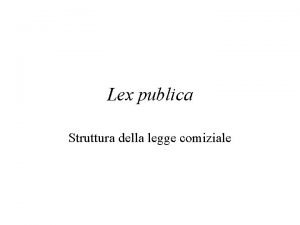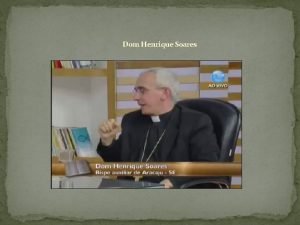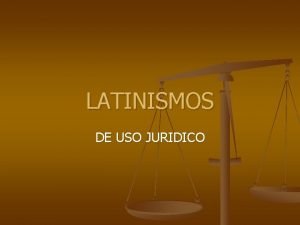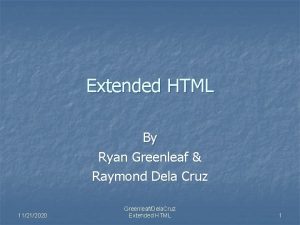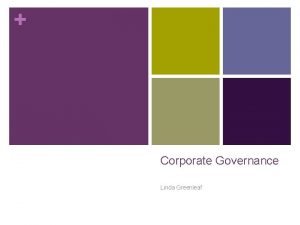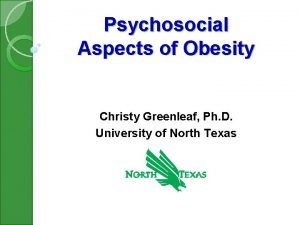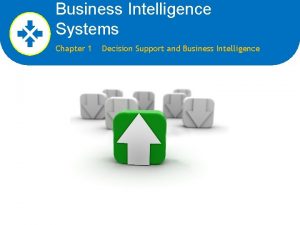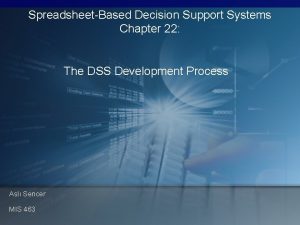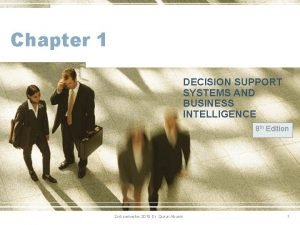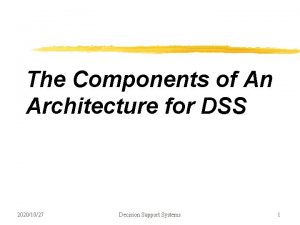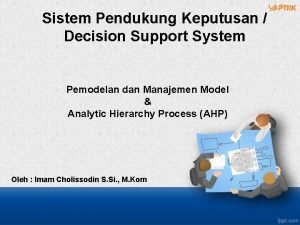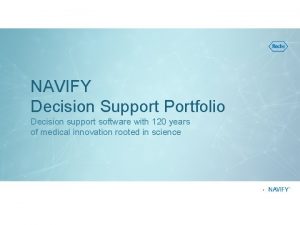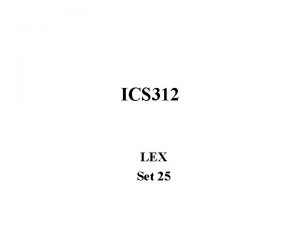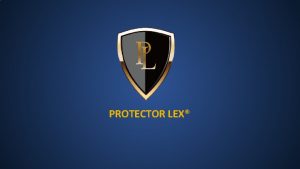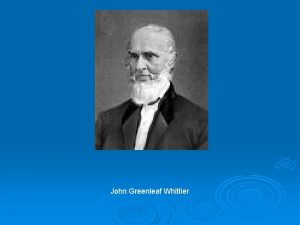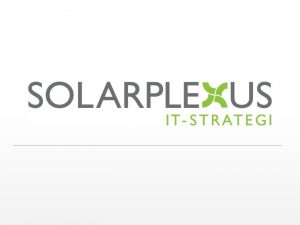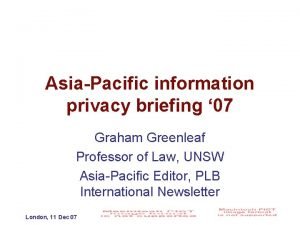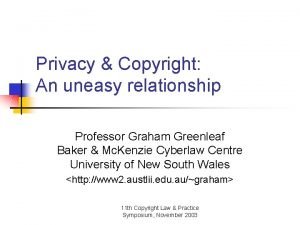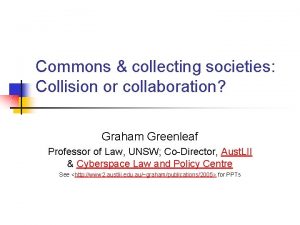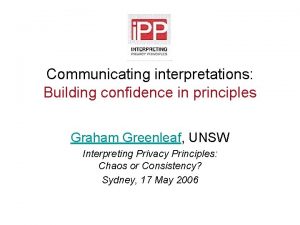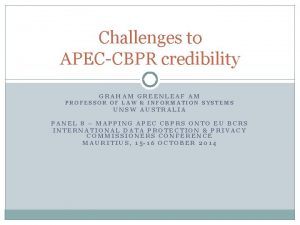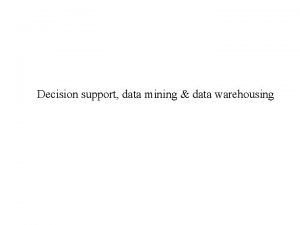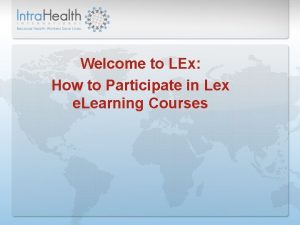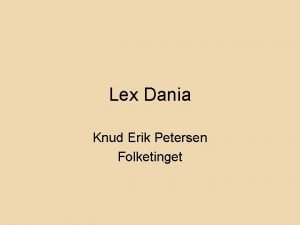Data Lex decision support systems Graham Greenleaf Philip



















- Slides: 19

Data. Lex decision support systems Graham Greenleaf & Philip Chung UNSW Faculty of Law 5 September 2017

Background • Another wave of ‘AI & law’ – 1 st wave (50 s & 60 s): building blocks of intelligence – 2 nd wave (80 s to mid-90 s): ‘expert systems’ and logic programming; ended with 2001 dot. com crash – 3 rd wave (2010? –): still cresting • Data. Lex Project (1984 -2001) was part of the 2 nd wave – see history in paper – learned from experience • New Data. Lex Project (2017 -) focuses on (i) the needs of free legal advice providers (‘commons of expertise’); (ii) sustainability; and (iii) relationship to free access law resources. • Paper suggests 15 ideas that still seem to make sense from the perspective of developing sustainable free legal advisory systems • Aust. LII is assembling and further developing tools to build legal decision support systems, with an emphasis on integrating all forms of content needed for sustainable free legal advisory systems

1. Law is not ‘just another problem domain’ • Law is a difficult and unusual problem domain • Different types of legal expertise may need to be modeled. • At least 5 types of legal systems may be built. • Data. Lex approach focuses on formal legal advisory systems: conclusions supported by legally convincing reasons. – Other objectives require different tools.

2. Expertise is relative • ‘Expert’ depends on context – including limited resources, esp. computing expertise – assumption behind the Data. Lex approach. • ‘This problem appears to be beyond the expertise of this system’ – successful advice, triaging human expertise to where needed most.

3. No AI tool suits all types of problems • Fundamental question: is a ‘correct’ (useful) answer sufficient? – Or are justifications based on legal sources required? • Answer determines which types of tools can be used. • Eg Where is machine learning possible/useful? – Document discovery systems have training sets

4. Start with legislation, not case law • Can sustainable free access systems use casebased reasoning? – A principal focus of AI & law research for 40 years (see 15 vols of ICAIL Proceedings 1987 -2017) – Theoretical basis still in dispute, no agreed approach – Identification/encoding of attributes in cases is costly • Tutorial part 12: PANNDA approach in Data. Lex • More practical: alert users when case-based reasoning is required, and assist them to get to the cases needed to resolve a question.

5. Aim to handle complexity • Good to start with simple problems, BUT • Computers can out-perform humans in handling (some) complexity in a thorough way – complexity is the boring part of expertise – ‘capture complexity once only’ is a good aim • Rule-based reasoning can be ideal for this

6. Users organisations should maintain their own knowledge-bases • Expert systems paradigm = domain expert(s) + knowledge engineer + KB shell – But Knowledge Engineers were rare & expensive • The Knowledge Acquisition Bottleneck – the key problem of previous AI &Law – Endemic, except if ML/training sets apply • Becomes desirable/necessary for lawyers to build/maintain their own knowledge-bases – Particularly those with few financial resources

7. Use declarative knowledge representations where possible • Declarative knowledge representations: state domain knowledge as rules, but not its order of application – Contra: Procedural knowledge representations: knowledge + application order combined • Except for simple problems, declarative representations are preferable – Legal procedures are best presented as procedural code – Document generation (Tutorial part 11) also requires it • Tutorial part 3 ‘Simple backward and forward chaining rules’ (Handout) – Data. Lex Community ‘Goal Tests’ run these examples – What must you know about rule-based reasoning?

8. Isomorphic representations are desirable • Isomorphism: as close as possible to a one-to-one correspondence between legal sources and knowledge -base (KB) – It is only an ideal, can never be achieved fully • Advantages: essentially Qs of transparency – Easier for legal experts to audit whether the KB is an acceptable representation of the law – When law changes, easier to identify which part of KB to change – As KB becomes more complex, isomorphism becomes more valuable • Example: Copyright Law KB (circa. 1997)

9. Quasi-natural-language knowledgebases avoid repetitive coding • Symbolic representations have disadvantages – Legal experts cannot audit/understand them – Both dialogues (questions) and explanations/conclusions are separate from the KB; isomorphism is largely lost – These can all get ‘out of synch’, particularly when the law changes • Alternative: quasi-natural language representations – Tutorial parts 4, 6 & 7 explain this – Faster to develop, as no repetitive coding; other advantages come from higher isomorphism – Example: run the FOI consultation, testing run-time options, and the two forms of checks (Tutorial part 7)

10. Propositional representation is enough for most tasks • Predicate calculus, where multiple instances of the same variable can have different values, is only infrequently required. – Becomes very difficult for legal experts to understand or modify • Others (eg Bench-Capon) have similarly concluded that propositional logic is sufficient for most types of legal reasoning.

11. Inferencing is not enough for decision support • Interpretation issues cannot be eliminated from knowledge-bases (KBs) – Rule-based reasoning is rarely sufficient • So inferencing systems cannot be ‘closed’ – must allow/assist users to access legal sources, to interpret where required – must allow/assist users to check if law has changed since the KB was written

12. Semi-expert systems and users collaborate • ‘Robot lawyers’ are a misconception • Real model is a legal decision support system – collaboration between a semi-expert computer system, and a semi-expert user – control of a problem’s resolution alternates between them • System design, and extent of reliance on the user’s expertise, depend on extent of expertise of the intended/likely users.

13. Legal expertise can and should be captured by multiple means • Knowledge-bases (KBs) are only the obvious form of capturing legal expertise • All technologies for utilising legal information allow legal expertise to be stored and re-used – Traditional: citators, textbooks etc • All available new technologies (eg text retrieval, hypertext) should be used • Integration between KBs and other forms of stored expertise is key

14. Automate hypertext linking from knowledge-bases • Hypertext links and stored searches from dialogues and explanations increase user ability to answer questions and understand explanations – to definitions, cases, citators, commentary etc – can be both automated and hand-crafted. • Run the FINDER application – Alan Tyree wrote FINDER in 1987; there were only a handful of finding cases to include.

15. Collaborative knowledge-bases can crowd-source development • Parts of knowledge-bases can be distributed across different websites – invoked remotely as part of a consultation – Helps distribute maintenance and development costs of complex knowledge-bases • Tutorial part 10 ‘Cooperative inferencing’

References • Aust. LII Communities: Data. Lex http: //austlii. community/foswiki/Data. Lex/Web. Home • Greenleaf, Mowbray & Chung (2017) ‘Building sustainable free legal advisory systems: Experiences from the history of AI & law’ (SSRN or Aust. LII) • Greenleaf, Chung & Mowbray (2017) ‘Building Data. Lex decision support systems: A tutorial on rule-based reasoning in law’ (SSRN or Aust. LII) • Data. Lex bibliography – in Greenleaf, Mowbray& Chung (above)

‘Goaltest’ Rule • Rule 1 • Rule 2 • Rule 3 • Rule 4 • Rule 5 Conditions Conclusion E and F A A and (B or C) D E or G C H and G and C and not F A F and not E not D • E, H and G are correct (true) • F and B are not correct (false)
 Lex publica
Lex publica Lex orandi, lex credendi
Lex orandi, lex credendi Dura la ley pero es la ley en latin
Dura la ley pero es la ley en latin Decision support systems and intelligent systems
Decision support systems and intelligent systems Operational data vs decision support data
Operational data vs decision support data Objectives of decision making
Objectives of decision making Financial decision
Financial decision Ryan greenleaf
Ryan greenleaf Linda greenleaf
Linda greenleaf Christy greenleaf
Christy greenleaf Greenleaf carbide
Greenleaf carbide Decision support and business intelligence systems
Decision support and business intelligence systems Developing spreadsheet-based decision support systems
Developing spreadsheet-based decision support systems Decision support system in business intelligence
Decision support system in business intelligence Decision support and expert systems
Decision support and expert systems Decision table and decision tree examples
Decision table and decision tree examples Transaction processing system examples
Transaction processing system examples Dss architecture components
Dss architecture components Contoh spk motor honda
Contoh spk motor honda Navify decision support
Navify decision support
